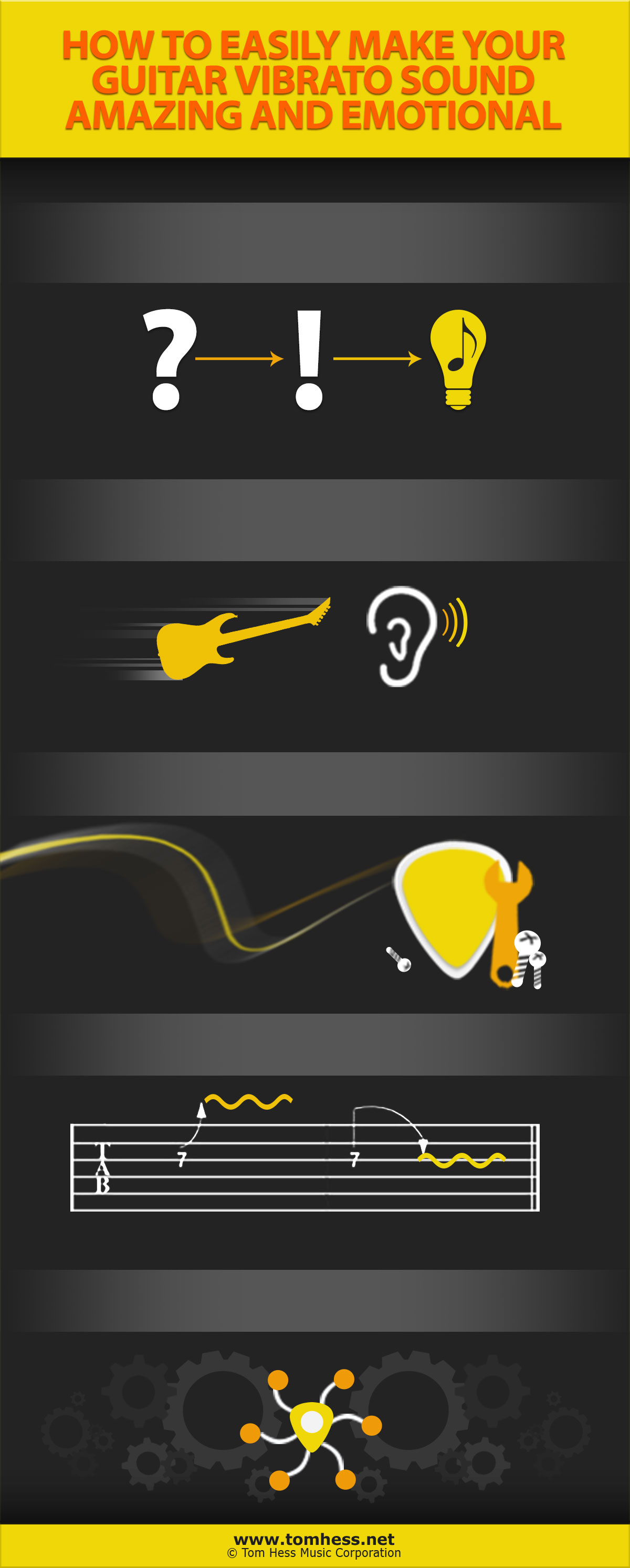So how do you actually master lead guitar vibrato technique?
Here is the process:
...break this technique down to its fundamentals, practice each element separately and then integrate them together.
Want to see exactly how to do this?
Watch this video to see the process of developing great lead guitar vibrato technique:
Here are 5 tips that will help you master lead guitar vibrato technique fast:
1. Know What You Are Looking For
When you practice lead guitar vibrato technique, be clear on what sound you are looking for… and what sound you are NOT looking for.
There IS a very clear difference between good lead guitar vibrato technique and bad lead guitar vibrato technique. Watch the video above to hear many examples of both types of vibrato and pay attention to its sound when you practice.
Emotion To Any Guitar Lick

EMAIL TO GET ACCESS
By submitting your info, you agree to send it to Tom Hess Music Corporation who will process and use it according to their privacy policy.
 (Bad vibrato is the opposite of one or more of those things).
(Bad vibrato is the opposite of one or more of those things).
This does NOT mean that good lead guitar vibrato must sound “the same way all the time”. The sound of good vibrato may vary depending on your musical style and context.
Sometimes narrow and slow guitar vibrato is the best vibrato for a certain musical situation (hear an example).
Other times fast and wide guitar vibrato is the best for expressing intense power, intensity and drama (hear an example).
The above 2 examples are both controlled and in tune. They may be either good or bad depending on the context they are used in. (Of course many other kinds of good vibrato also exist in between these extremes.)
Here is an example of vibrato that is both out of tune and uncontrolled: hear it. This kind of vibrato always sounds bad (in any context) - avoid it.
Determine what kind of vibrato expresses the exact emotion you want to convey in your music and focus on achieving that sound when you practice lead guitar. To get help with this, download this free eBook about adding fire and intensity to your guitar licks.
2. Allow Your Hands To Catch Up To Your Ears
The physical motions of playing guitar vibrato are very simple. All you do is wrap your thumb around the neck of the guitar and rotate your forearm/wrist to do vibrato. The hard part is training your ears to guide your hands to produce the sound you want to hear.
When you play guitar vibrato and it doesn't sound quite right, ask yourself: “What am I missing?” Is the vibrato too slow? Is it too fast? Is it inconsistent? (some pulses are wider or faster than others). Is it too wide? Too narrow? Asking these questions will guide your hands to make the adjustments needed to match the sound you hear in your head.
Do this to develop your ear for identifying good guitar vibrato, so you can master it faster:
- Listen to your favorite guitarists and pay attention to how they use vibrato.
- Listen to the vibrato of your favorite singers and mimic their vibrato phrasing style in your own guitar licks (for help with this, read this article about how to play better guitar solos).
- Alternate good vibrato with intentionally making your vibrato too fast, too narrow, out of tune and inconsistent. Doing this will make your ears more sensitive to the contrast between good and bad vibrato.
 Become A Better Lead Guitarist
Become A Better Lead GuitaristLearn the key factor for how to
become a better lead guitarist.
 How To Play Killer Guitar Vibrato
How To Play Killer Guitar VibratoImprove your vibrato technique
by watching a killer guitar video.
 Improve Your Lead Guitar Solos
Improve Your Lead Guitar SolosLearn how to immediately play
killer lead guitar solo phrases.
3. Practice “Delayed Lead Guitar Vibrato Technique”
Instead of rushing to apply guitar vibrato as soon as the note is played, let the note ring out for about a second and then apply vibrato. This will improve your phrasing in 2 ways:
- Using delayed guitar vibrato will make your guitar phrases more dramatic by bringing attention to the vibrato when it is applied.
- Delaying the vibrato prevents you from rushing, tensing up and making your vibrato too fast/narrow and out of control.
See/hear this technique demonstrated starting at 3:18 in the video.
Of course there are times when applying vibrato to a note immediately can also sound great. You will have a much easier time doing this after you learn to do a controlled/delayed guitar vibrato technique(but not the other way around).
4. Practice Lead Guitar Vibrato Technique On Bent And Unbent Notes
Once you can consistently get the vibrato sound you want on an unbent note, begin applying the same approach to a bent note.
Follow these steps:
Step 1. Choose a note you want to bend (starting note) and determine the note you are bending up to (target note). For example: from a starting note on fret 7 on the G string, bend up to the target note on fret 9.
Step 2. Pick the starting note and bend it.
Step 3. Once the pitch matches that of the target note, wait for a moment while the string rings out (delaying the guitar vibrato).
Step 4. Strike the string again and apply vibrato (immediately).
Step 5. Repeat this several times.
Step 6. Move to a new area of the fretboard (such as around the 20th fret or above, or the lower frets/strings) and start the process over. Repeat this several times for 3-5 minutes.
To hear an example of this, watch this video (the demonstration starts at 2:55 in the video).
5. Practice Integration Through Variations
Practicing lead guitar vibrato technique in isolation is not enough. You must learn how to vary the sound, speed and width of the vibrato to match the music you are playing. Take a single guitar lick and practice creating dozens of phrasing variations on it (varying how the notes are played). This will get you to fully integrate lead guitar vibrato into your guitar playing in a fluent way.
To hear lots of examples of how to do this (and to get more help with mastering lead guitar vibrato technique), download this free eBook about playing emotional guitar licks.

